Diabetes: Causes, Symptoms, and Diagnosis
VerifiedAdded on 2023/01/06
|11
|4059
|80
AI Summary
This document provides an overview of diabetes, focusing on type 2 diabetes. It explains the meaning of diabetes, the difference between type 1 and type 2 diabetes, the causes of type 2 diabetes, and the signs and symptoms associated with it. The document also discusses the clinical investigations used for the diagnosis of type 2 diabetes and examines the treatment and support available for individuals with type 2 diabetes, including the initial diagnosis and long-term complications. References are provided for further reading.
Contribute Materials
Your contribution can guide someone’s learning journey. Share your
documents today.
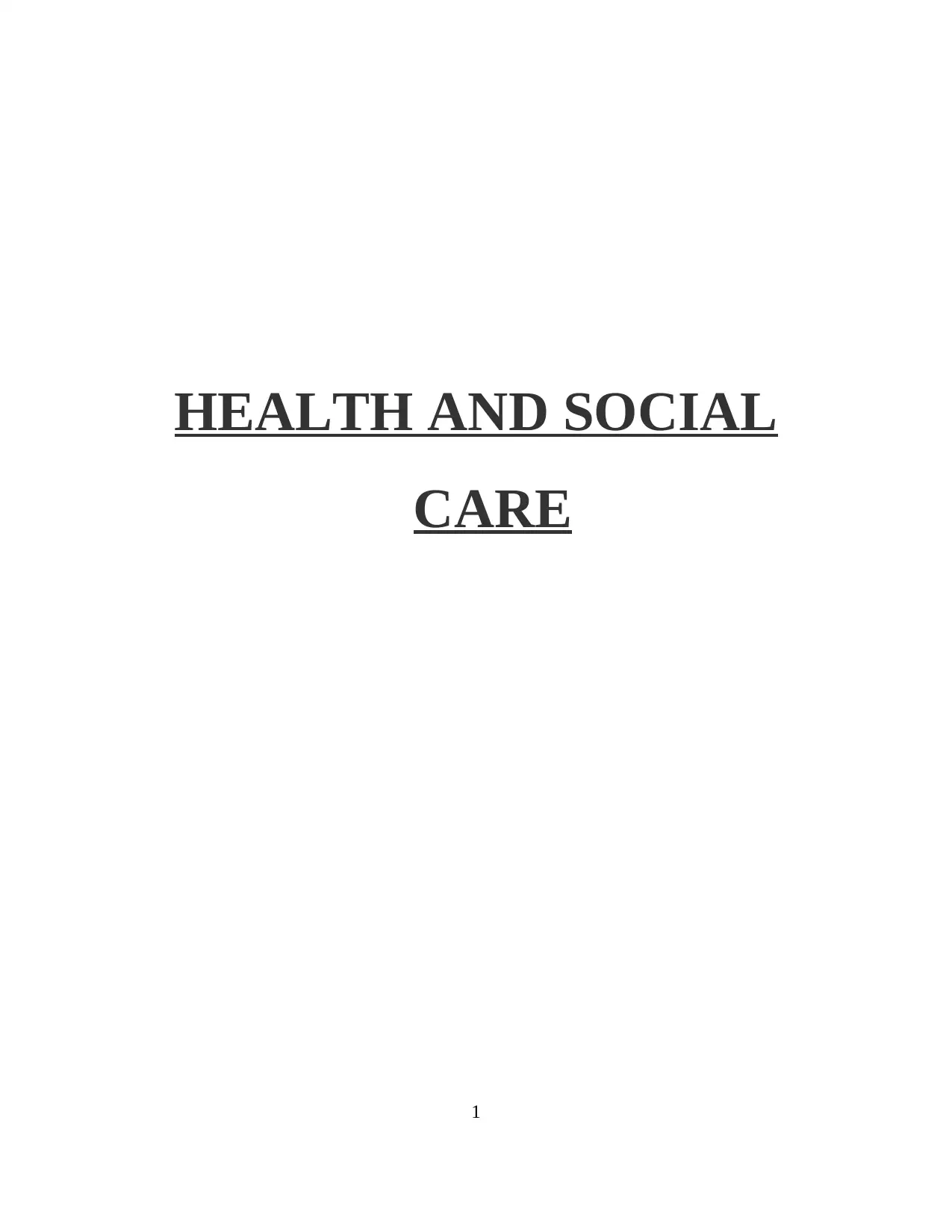
HEALTH AND SOCIAL
CARE
1
CARE
1
Secure Best Marks with AI Grader
Need help grading? Try our AI Grader for instant feedback on your assignments.
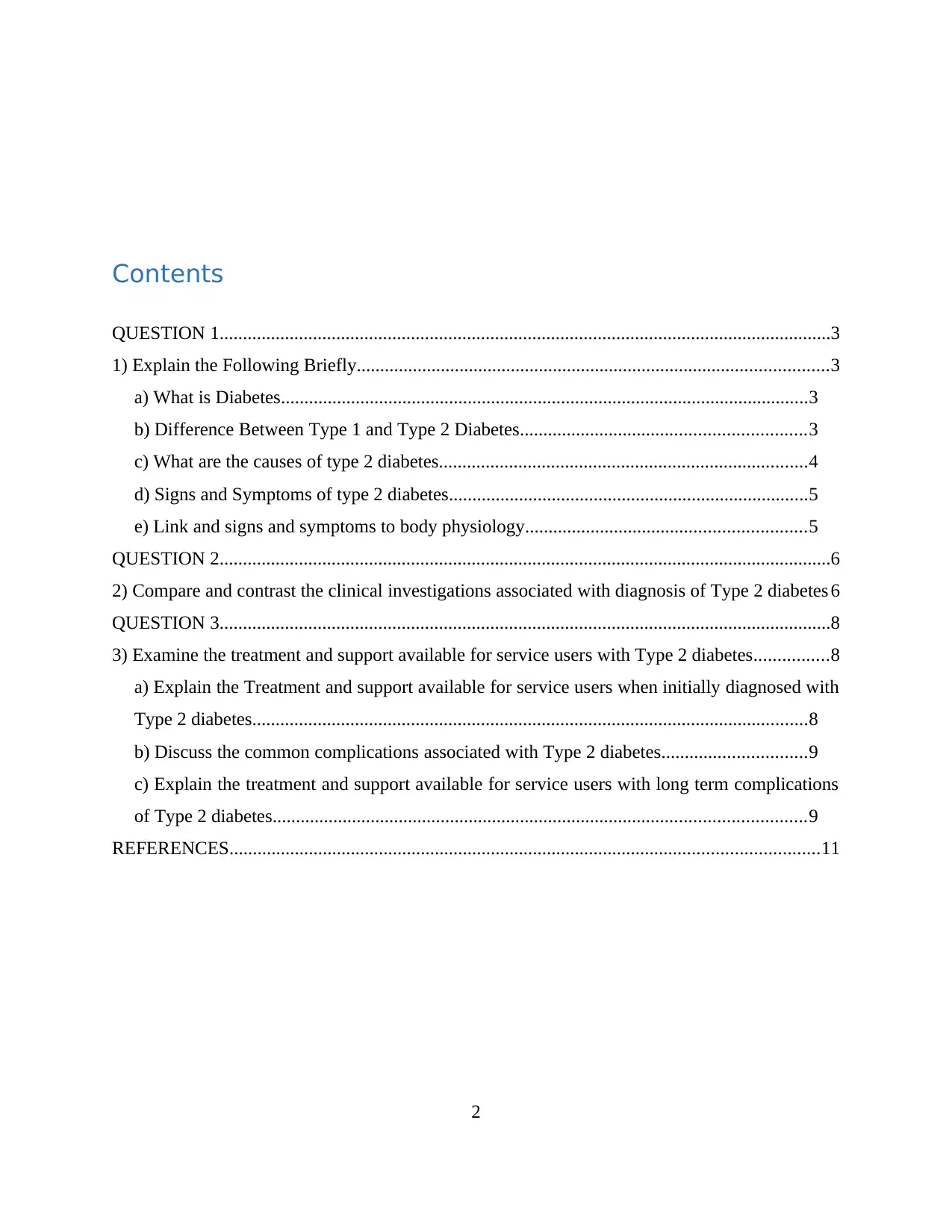
Contents
QUESTION 1...................................................................................................................................3
1) Explain the Following Briefly.....................................................................................................3
a) What is Diabetes.................................................................................................................3
b) Difference Between Type 1 and Type 2 Diabetes.............................................................3
c) What are the causes of type 2 diabetes...............................................................................4
d) Signs and Symptoms of type 2 diabetes.............................................................................5
e) Link and signs and symptoms to body physiology............................................................5
QUESTION 2...................................................................................................................................6
2) Compare and contrast the clinical investigations associated with diagnosis of Type 2 diabetes 6
QUESTION 3...................................................................................................................................8
3) Examine the treatment and support available for service users with Type 2 diabetes................8
a) Explain the Treatment and support available for service users when initially diagnosed with
Type 2 diabetes.......................................................................................................................8
b) Discuss the common complications associated with Type 2 diabetes...............................9
c) Explain the treatment and support available for service users with long term complications
of Type 2 diabetes..................................................................................................................9
REFERENCES..............................................................................................................................11
2
QUESTION 1...................................................................................................................................3
1) Explain the Following Briefly.....................................................................................................3
a) What is Diabetes.................................................................................................................3
b) Difference Between Type 1 and Type 2 Diabetes.............................................................3
c) What are the causes of type 2 diabetes...............................................................................4
d) Signs and Symptoms of type 2 diabetes.............................................................................5
e) Link and signs and symptoms to body physiology............................................................5
QUESTION 2...................................................................................................................................6
2) Compare and contrast the clinical investigations associated with diagnosis of Type 2 diabetes 6
QUESTION 3...................................................................................................................................8
3) Examine the treatment and support available for service users with Type 2 diabetes................8
a) Explain the Treatment and support available for service users when initially diagnosed with
Type 2 diabetes.......................................................................................................................8
b) Discuss the common complications associated with Type 2 diabetes...............................9
c) Explain the treatment and support available for service users with long term complications
of Type 2 diabetes..................................................................................................................9
REFERENCES..............................................................................................................................11
2
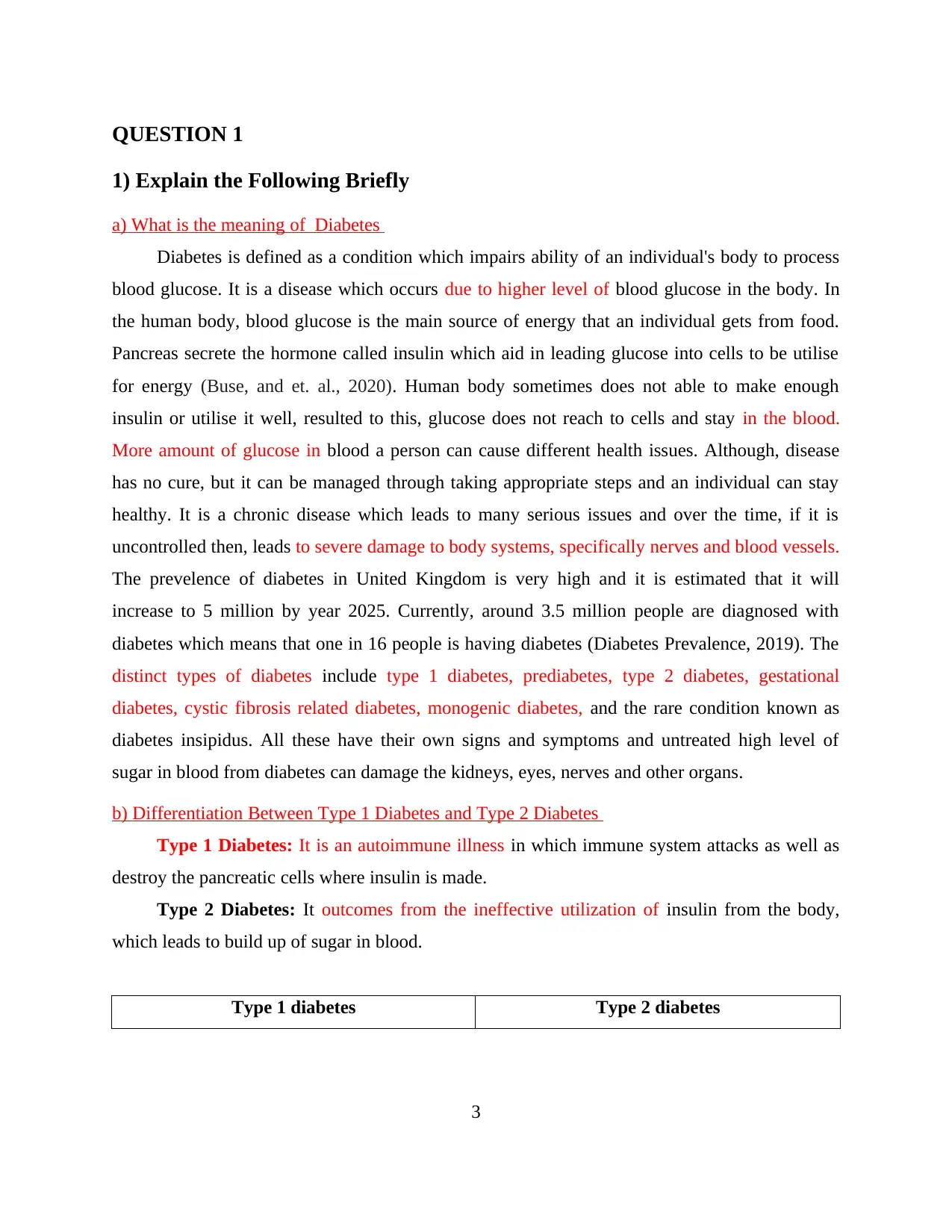
QUESTION 1
1) Explain the Following Briefly
a) What is the meaning of Diabetes
Diabetes is defined as a condition which impairs ability of an individual's body to process
blood glucose. It is a disease which occurs due to higher level of blood glucose in the body. In
the human body, blood glucose is the main source of energy that an individual gets from food.
Pancreas secrete the hormone called insulin which aid in leading glucose into cells to be utilise
for energy (Buse, and et. al., 2020). Human body sometimes does not able to make enough
insulin or utilise it well, resulted to this, glucose does not reach to cells and stay in the blood.
More amount of glucose in blood a person can cause different health issues. Although, disease
has no cure, but it can be managed through taking appropriate steps and an individual can stay
healthy. It is a chronic disease which leads to many serious issues and over the time, if it is
uncontrolled then, leads to severe damage to body systems, specifically nerves and blood vessels.
The prevelence of diabetes in United Kingdom is very high and it is estimated that it will
increase to 5 million by year 2025. Currently, around 3.5 million people are diagnosed with
diabetes which means that one in 16 people is having diabetes (Diabetes Prevalence, 2019). The
distinct types of diabetes include type 1 diabetes, prediabetes, type 2 diabetes, gestational
diabetes, cystic fibrosis related diabetes, monogenic diabetes, and the rare condition known as
diabetes insipidus. All these have their own signs and symptoms and untreated high level of
sugar in blood from diabetes can damage the kidneys, eyes, nerves and other organs.
b) Differentiation Between Type 1 Diabetes and Type 2 Diabetes
Type 1 Diabetes: It is an autoimmune illness in which immune system attacks as well as
destroy the pancreatic cells where insulin is made.
Type 2 Diabetes: It outcomes from the ineffective utilization of insulin from the body,
which leads to build up of sugar in blood.
Type 1 diabetes Type 2 diabetes
3
1) Explain the Following Briefly
a) What is the meaning of Diabetes
Diabetes is defined as a condition which impairs ability of an individual's body to process
blood glucose. It is a disease which occurs due to higher level of blood glucose in the body. In
the human body, blood glucose is the main source of energy that an individual gets from food.
Pancreas secrete the hormone called insulin which aid in leading glucose into cells to be utilise
for energy (Buse, and et. al., 2020). Human body sometimes does not able to make enough
insulin or utilise it well, resulted to this, glucose does not reach to cells and stay in the blood.
More amount of glucose in blood a person can cause different health issues. Although, disease
has no cure, but it can be managed through taking appropriate steps and an individual can stay
healthy. It is a chronic disease which leads to many serious issues and over the time, if it is
uncontrolled then, leads to severe damage to body systems, specifically nerves and blood vessels.
The prevelence of diabetes in United Kingdom is very high and it is estimated that it will
increase to 5 million by year 2025. Currently, around 3.5 million people are diagnosed with
diabetes which means that one in 16 people is having diabetes (Diabetes Prevalence, 2019). The
distinct types of diabetes include type 1 diabetes, prediabetes, type 2 diabetes, gestational
diabetes, cystic fibrosis related diabetes, monogenic diabetes, and the rare condition known as
diabetes insipidus. All these have their own signs and symptoms and untreated high level of
sugar in blood from diabetes can damage the kidneys, eyes, nerves and other organs.
b) Differentiation Between Type 1 Diabetes and Type 2 Diabetes
Type 1 Diabetes: It is an autoimmune illness in which immune system attacks as well as
destroy the pancreatic cells where insulin is made.
Type 2 Diabetes: It outcomes from the ineffective utilization of insulin from the body,
which leads to build up of sugar in blood.
Type 1 diabetes Type 2 diabetes
3
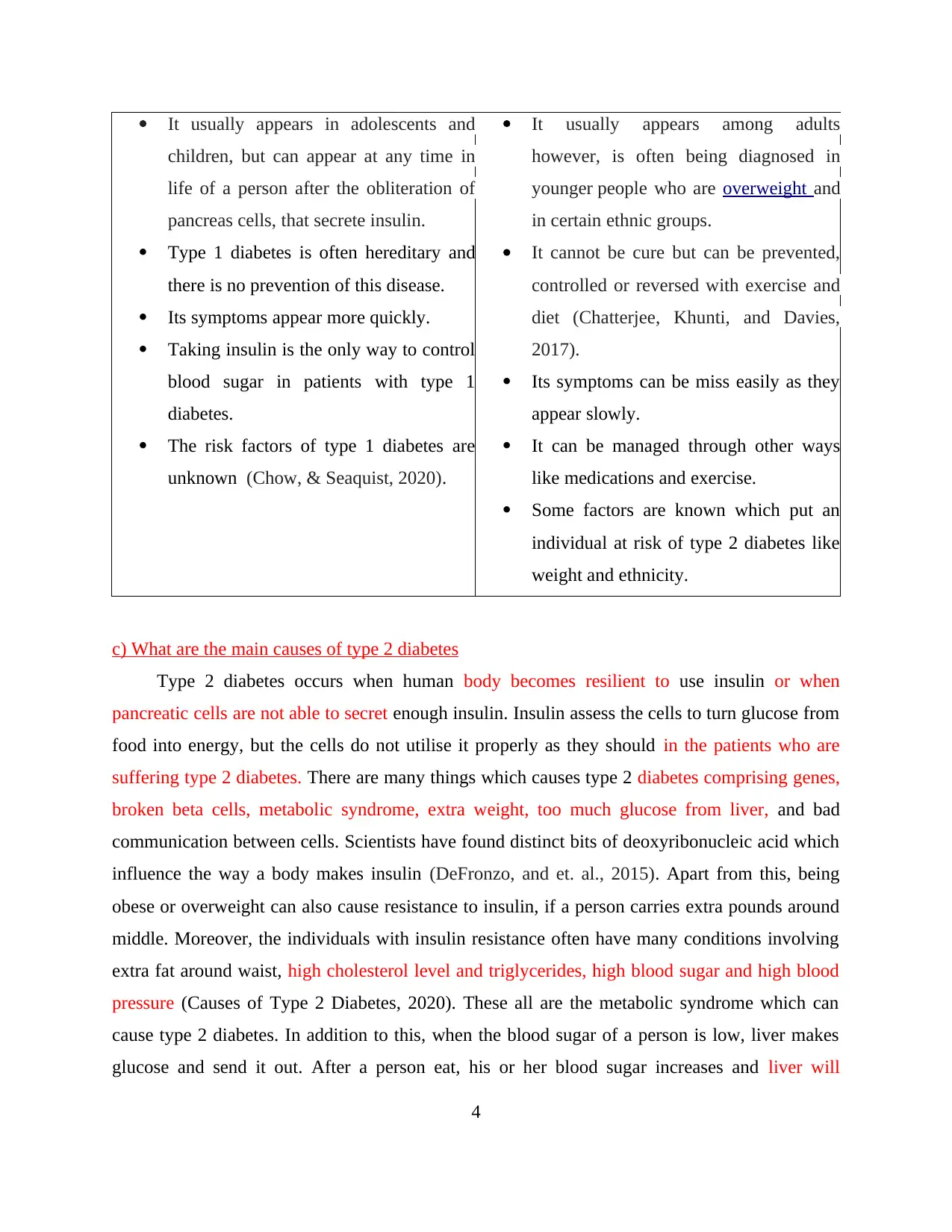
It usually appears in adolescents and
children, but can appear at any time in
life of a person after the obliteration of
pancreas cells, that secrete insulin.
Type 1 diabetes is often hereditary and
there is no prevention of this disease.
Its symptoms appear more quickly.
Taking insulin is the only way to control
blood sugar in patients with type 1
diabetes.
The risk factors of type 1 diabetes are
unknown (Chow, & Seaquist, 2020).
It usually appears among adults
however, is often being diagnosed in
younger people who are overweight and
in certain ethnic groups.
It cannot be cure but can be prevented,
controlled or reversed with exercise and
diet (Chatterjee, Khunti, and Davies,
2017).
Its symptoms can be miss easily as they
appear slowly.
It can be managed through other ways
like medications and exercise.
Some factors are known which put an
individual at risk of type 2 diabetes like
weight and ethnicity.
c) What are the main causes of type 2 diabetes
Type 2 diabetes occurs when human body becomes resilient to use insulin or when
pancreatic cells are not able to secret enough insulin. Insulin assess the cells to turn glucose from
food into energy, but the cells do not utilise it properly as they should in the patients who are
suffering type 2 diabetes. There are many things which causes type 2 diabetes comprising genes,
broken beta cells, metabolic syndrome, extra weight, too much glucose from liver, and bad
communication between cells. Scientists have found distinct bits of deoxyribonucleic acid which
influence the way a body makes insulin (DeFronzo, and et. al., 2015). Apart from this, being
obese or overweight can also cause resistance to insulin, if a person carries extra pounds around
middle. Moreover, the individuals with insulin resistance often have many conditions involving
extra fat around waist, high cholesterol level and triglycerides, high blood sugar and high blood
pressure (Causes of Type 2 Diabetes, 2020). These all are the metabolic syndrome which can
cause type 2 diabetes. In addition to this, when the blood sugar of a person is low, liver makes
glucose and send it out. After a person eat, his or her blood sugar increases and liver will
4
children, but can appear at any time in
life of a person after the obliteration of
pancreas cells, that secrete insulin.
Type 1 diabetes is often hereditary and
there is no prevention of this disease.
Its symptoms appear more quickly.
Taking insulin is the only way to control
blood sugar in patients with type 1
diabetes.
The risk factors of type 1 diabetes are
unknown (Chow, & Seaquist, 2020).
It usually appears among adults
however, is often being diagnosed in
younger people who are overweight and
in certain ethnic groups.
It cannot be cure but can be prevented,
controlled or reversed with exercise and
diet (Chatterjee, Khunti, and Davies,
2017).
Its symptoms can be miss easily as they
appear slowly.
It can be managed through other ways
like medications and exercise.
Some factors are known which put an
individual at risk of type 2 diabetes like
weight and ethnicity.
c) What are the main causes of type 2 diabetes
Type 2 diabetes occurs when human body becomes resilient to use insulin or when
pancreatic cells are not able to secret enough insulin. Insulin assess the cells to turn glucose from
food into energy, but the cells do not utilise it properly as they should in the patients who are
suffering type 2 diabetes. There are many things which causes type 2 diabetes comprising genes,
broken beta cells, metabolic syndrome, extra weight, too much glucose from liver, and bad
communication between cells. Scientists have found distinct bits of deoxyribonucleic acid which
influence the way a body makes insulin (DeFronzo, and et. al., 2015). Apart from this, being
obese or overweight can also cause resistance to insulin, if a person carries extra pounds around
middle. Moreover, the individuals with insulin resistance often have many conditions involving
extra fat around waist, high cholesterol level and triglycerides, high blood sugar and high blood
pressure (Causes of Type 2 Diabetes, 2020). These all are the metabolic syndrome which can
cause type 2 diabetes. In addition to this, when the blood sugar of a person is low, liver makes
glucose and send it out. After a person eat, his or her blood sugar increases and liver will
4
Secure Best Marks with AI Grader
Need help grading? Try our AI Grader for instant feedback on your assignments.
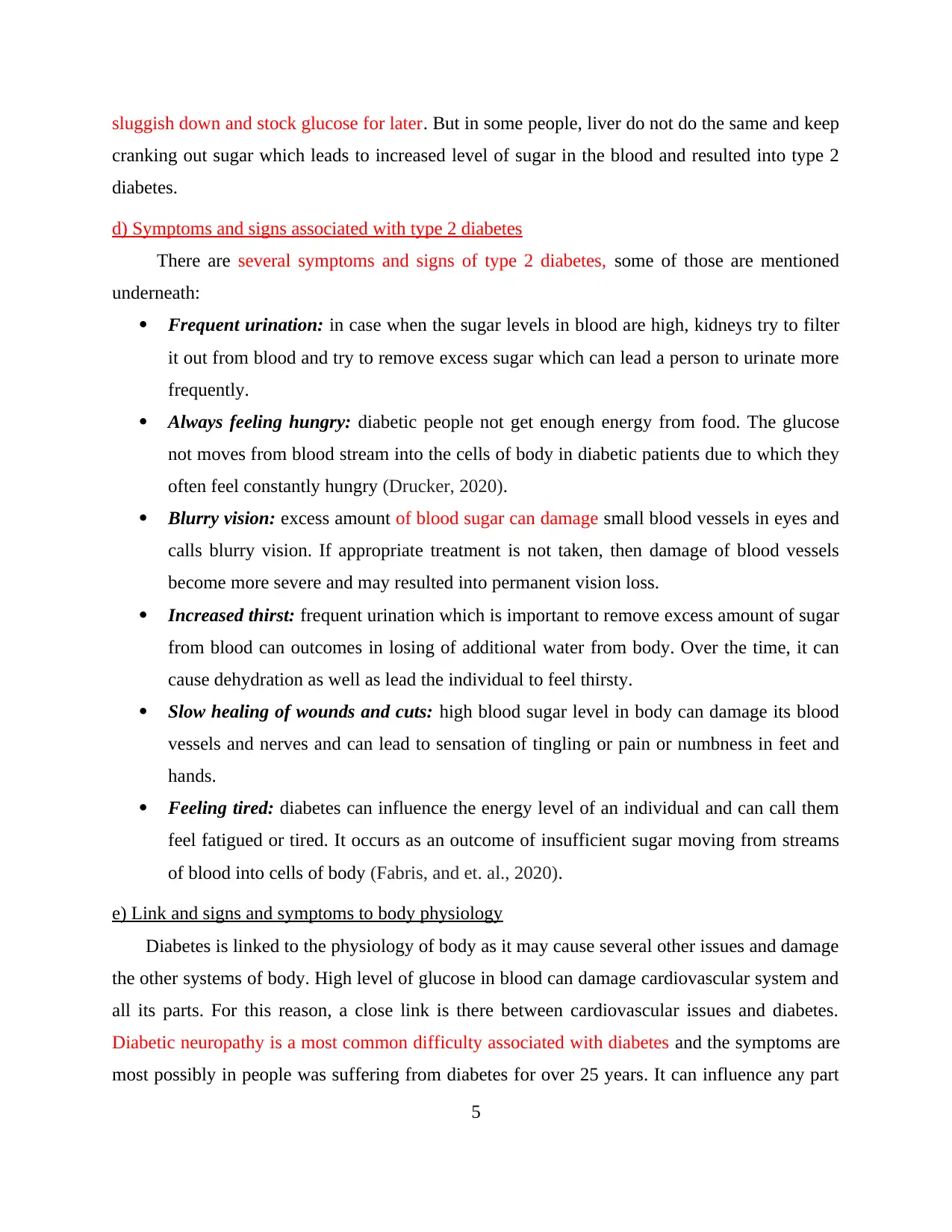
sluggish down and stock glucose for later. But in some people, liver do not do the same and keep
cranking out sugar which leads to increased level of sugar in the blood and resulted into type 2
diabetes.
d) Symptoms and signs associated with type 2 diabetes
There are several symptoms and signs of type 2 diabetes, some of those are mentioned
underneath:
Frequent urination: in case when the sugar levels in blood are high, kidneys try to filter
it out from blood and try to remove excess sugar which can lead a person to urinate more
frequently.
Always feeling hungry: diabetic people not get enough energy from food. The glucose
not moves from blood stream into the cells of body in diabetic patients due to which they
often feel constantly hungry (Drucker, 2020).
Blurry vision: excess amount of blood sugar can damage small blood vessels in eyes and
calls blurry vision. If appropriate treatment is not taken, then damage of blood vessels
become more severe and may resulted into permanent vision loss.
Increased thirst: frequent urination which is important to remove excess amount of sugar
from blood can outcomes in losing of additional water from body. Over the time, it can
cause dehydration as well as lead the individual to feel thirsty.
Slow healing of wounds and cuts: high blood sugar level in body can damage its blood
vessels and nerves and can lead to sensation of tingling or pain or numbness in feet and
hands.
Feeling tired: diabetes can influence the energy level of an individual and can call them
feel fatigued or tired. It occurs as an outcome of insufficient sugar moving from streams
of blood into cells of body (Fabris, and et. al., 2020).
e) Link and signs and symptoms to body physiology
Diabetes is linked to the physiology of body as it may cause several other issues and damage
the other systems of body. High level of glucose in blood can damage cardiovascular system and
all its parts. For this reason, a close link is there between cardiovascular issues and diabetes.
Diabetic neuropathy is a most common difficulty associated with diabetes and the symptoms are
most possibly in people was suffering from diabetes for over 25 years. It can influence any part
5
cranking out sugar which leads to increased level of sugar in the blood and resulted into type 2
diabetes.
d) Symptoms and signs associated with type 2 diabetes
There are several symptoms and signs of type 2 diabetes, some of those are mentioned
underneath:
Frequent urination: in case when the sugar levels in blood are high, kidneys try to filter
it out from blood and try to remove excess sugar which can lead a person to urinate more
frequently.
Always feeling hungry: diabetic people not get enough energy from food. The glucose
not moves from blood stream into the cells of body in diabetic patients due to which they
often feel constantly hungry (Drucker, 2020).
Blurry vision: excess amount of blood sugar can damage small blood vessels in eyes and
calls blurry vision. If appropriate treatment is not taken, then damage of blood vessels
become more severe and may resulted into permanent vision loss.
Increased thirst: frequent urination which is important to remove excess amount of sugar
from blood can outcomes in losing of additional water from body. Over the time, it can
cause dehydration as well as lead the individual to feel thirsty.
Slow healing of wounds and cuts: high blood sugar level in body can damage its blood
vessels and nerves and can lead to sensation of tingling or pain or numbness in feet and
hands.
Feeling tired: diabetes can influence the energy level of an individual and can call them
feel fatigued or tired. It occurs as an outcome of insufficient sugar moving from streams
of blood into cells of body (Fabris, and et. al., 2020).
e) Link and signs and symptoms to body physiology
Diabetes is linked to the physiology of body as it may cause several other issues and damage
the other systems of body. High level of glucose in blood can damage cardiovascular system and
all its parts. For this reason, a close link is there between cardiovascular issues and diabetes.
Diabetic neuropathy is a most common difficulty associated with diabetes and the symptoms are
most possibly in people was suffering from diabetes for over 25 years. It can influence any part
5
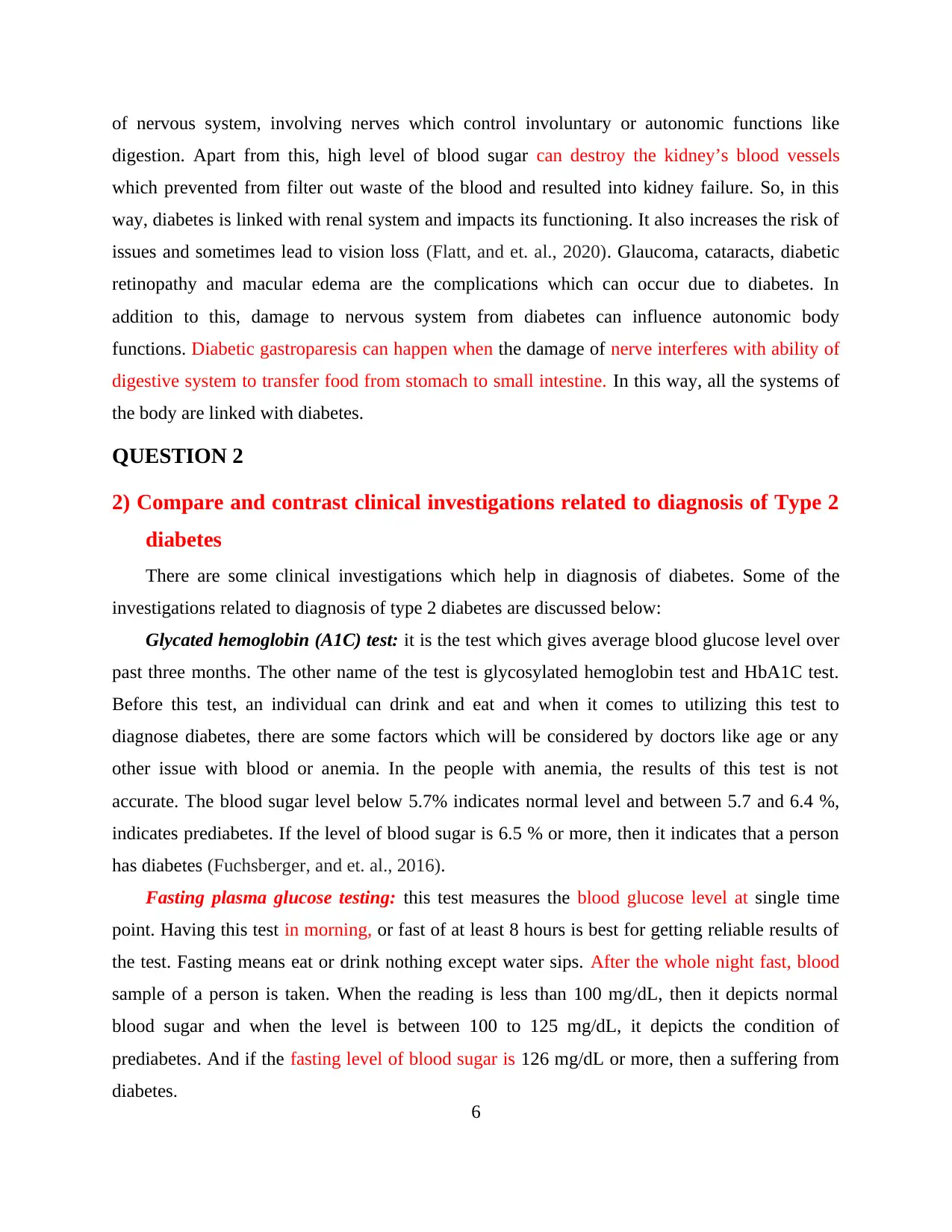
of nervous system, involving nerves which control involuntary or autonomic functions like
digestion. Apart from this, high level of blood sugar can destroy the kidney’s blood vessels
which prevented from filter out waste of the blood and resulted into kidney failure. So, in this
way, diabetes is linked with renal system and impacts its functioning. It also increases the risk of
issues and sometimes lead to vision loss (Flatt, and et. al., 2020). Glaucoma, cataracts, diabetic
retinopathy and macular edema are the complications which can occur due to diabetes. In
addition to this, damage to nervous system from diabetes can influence autonomic body
functions. Diabetic gastroparesis can happen when the damage of nerve interferes with ability of
digestive system to transfer food from stomach to small intestine. In this way, all the systems of
the body are linked with diabetes.
QUESTION 2
2) Compare and contrast clinical investigations related to diagnosis of Type 2
diabetes
There are some clinical investigations which help in diagnosis of diabetes. Some of the
investigations related to diagnosis of type 2 diabetes are discussed below:
Glycated hemoglobin (A1C) test: it is the test which gives average blood glucose level over
past three months. The other name of the test is glycosylated hemoglobin test and HbA1C test.
Before this test, an individual can drink and eat and when it comes to utilizing this test to
diagnose diabetes, there are some factors which will be considered by doctors like age or any
other issue with blood or anemia. In the people with anemia, the results of this test is not
accurate. The blood sugar level below 5.7% indicates normal level and between 5.7 and 6.4 %,
indicates prediabetes. If the level of blood sugar is 6.5 % or more, then it indicates that a person
has diabetes (Fuchsberger, and et. al., 2016).
Fasting plasma glucose testing: this test measures the blood glucose level at single time
point. Having this test in morning, or fast of at least 8 hours is best for getting reliable results of
the test. Fasting means eat or drink nothing except water sips. After the whole night fast, blood
sample of a person is taken. When the reading is less than 100 mg/dL, then it depicts normal
blood sugar and when the level is between 100 to 125 mg/dL, it depicts the condition of
prediabetes. And if the fasting level of blood sugar is 126 mg/dL or more, then a suffering from
diabetes.
6
digestion. Apart from this, high level of blood sugar can destroy the kidney’s blood vessels
which prevented from filter out waste of the blood and resulted into kidney failure. So, in this
way, diabetes is linked with renal system and impacts its functioning. It also increases the risk of
issues and sometimes lead to vision loss (Flatt, and et. al., 2020). Glaucoma, cataracts, diabetic
retinopathy and macular edema are the complications which can occur due to diabetes. In
addition to this, damage to nervous system from diabetes can influence autonomic body
functions. Diabetic gastroparesis can happen when the damage of nerve interferes with ability of
digestive system to transfer food from stomach to small intestine. In this way, all the systems of
the body are linked with diabetes.
QUESTION 2
2) Compare and contrast clinical investigations related to diagnosis of Type 2
diabetes
There are some clinical investigations which help in diagnosis of diabetes. Some of the
investigations related to diagnosis of type 2 diabetes are discussed below:
Glycated hemoglobin (A1C) test: it is the test which gives average blood glucose level over
past three months. The other name of the test is glycosylated hemoglobin test and HbA1C test.
Before this test, an individual can drink and eat and when it comes to utilizing this test to
diagnose diabetes, there are some factors which will be considered by doctors like age or any
other issue with blood or anemia. In the people with anemia, the results of this test is not
accurate. The blood sugar level below 5.7% indicates normal level and between 5.7 and 6.4 %,
indicates prediabetes. If the level of blood sugar is 6.5 % or more, then it indicates that a person
has diabetes (Fuchsberger, and et. al., 2016).
Fasting plasma glucose testing: this test measures the blood glucose level at single time
point. Having this test in morning, or fast of at least 8 hours is best for getting reliable results of
the test. Fasting means eat or drink nothing except water sips. After the whole night fast, blood
sample of a person is taken. When the reading is less than 100 mg/dL, then it depicts normal
blood sugar and when the level is between 100 to 125 mg/dL, it depicts the condition of
prediabetes. And if the fasting level of blood sugar is 126 mg/dL or more, then a suffering from
diabetes.
6
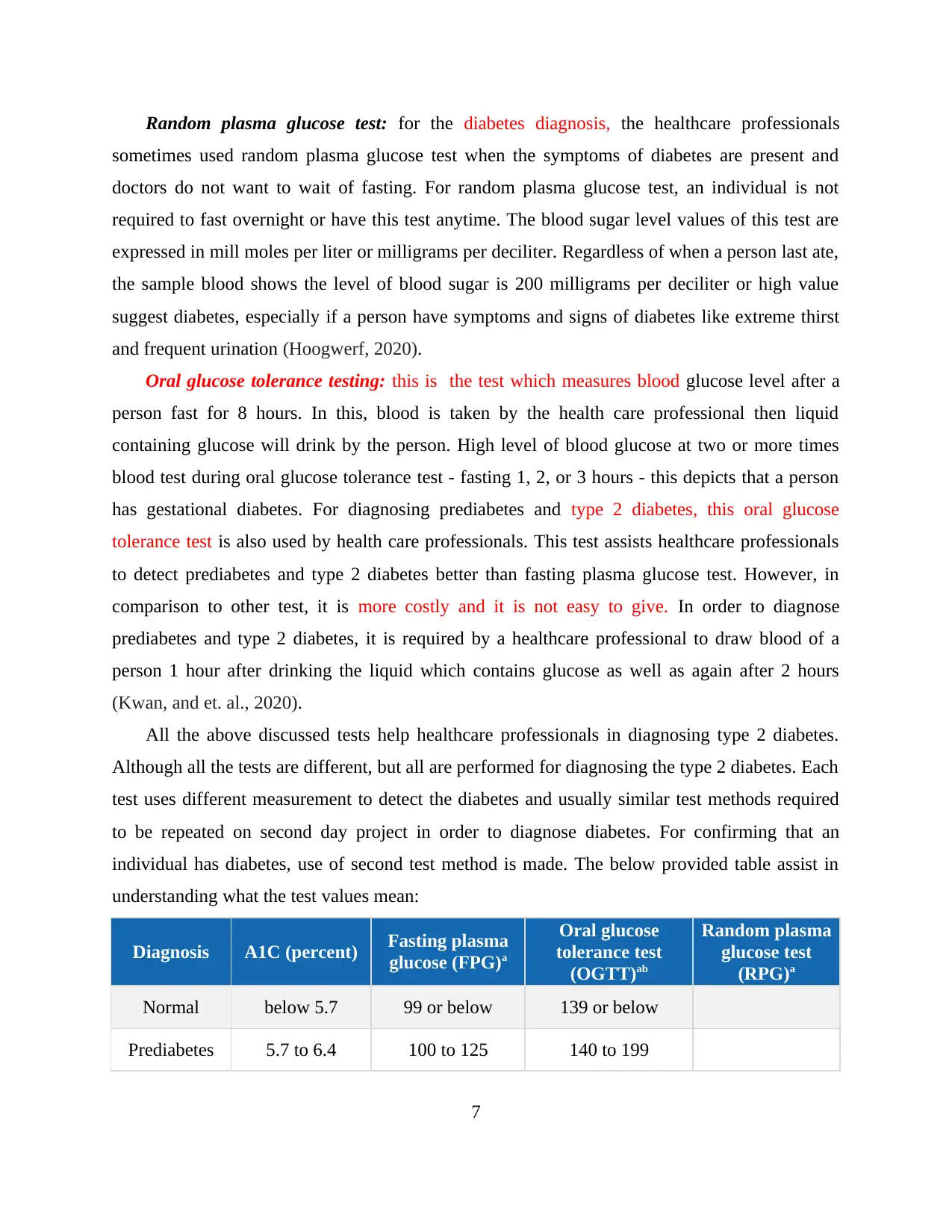
Random plasma glucose test: for the diabetes diagnosis, the healthcare professionals
sometimes used random plasma glucose test when the symptoms of diabetes are present and
doctors do not want to wait of fasting. For random plasma glucose test, an individual is not
required to fast overnight or have this test anytime. The blood sugar level values of this test are
expressed in mill moles per liter or milligrams per deciliter. Regardless of when a person last ate,
the sample blood shows the level of blood sugar is 200 milligrams per deciliter or high value
suggest diabetes, especially if a person have symptoms and signs of diabetes like extreme thirst
and frequent urination (Hoogwerf, 2020).
Oral glucose tolerance testing: this is the test which measures blood glucose level after a
person fast for 8 hours. In this, blood is taken by the health care professional then liquid
containing glucose will drink by the person. High level of blood glucose at two or more times
blood test during oral glucose tolerance test - fasting 1, 2, or 3 hours - this depicts that a person
has gestational diabetes. For diagnosing prediabetes and type 2 diabetes, this oral glucose
tolerance test is also used by health care professionals. This test assists healthcare professionals
to detect prediabetes and type 2 diabetes better than fasting plasma glucose test. However, in
comparison to other test, it is more costly and it is not easy to give. In order to diagnose
prediabetes and type 2 diabetes, it is required by a healthcare professional to draw blood of a
person 1 hour after drinking the liquid which contains glucose as well as again after 2 hours
(Kwan, and et. al., 2020).
All the above discussed tests help healthcare professionals in diagnosing type 2 diabetes.
Although all the tests are different, but all are performed for diagnosing the type 2 diabetes. Each
test uses different measurement to detect the diabetes and usually similar test methods required
to be repeated on second day project in order to diagnose diabetes. For confirming that an
individual has diabetes, use of second test method is made. The below provided table assist in
understanding what the test values mean:
Diagnosis A1C (percent) Fasting plasma
glucose (FPG)a
Oral glucose
tolerance test
(OGTT)ab
Random plasma
glucose test
(RPG)a
Normal below 5.7 99 or below 139 or below
Prediabetes 5.7 to 6.4 100 to 125 140 to 199
7
sometimes used random plasma glucose test when the symptoms of diabetes are present and
doctors do not want to wait of fasting. For random plasma glucose test, an individual is not
required to fast overnight or have this test anytime. The blood sugar level values of this test are
expressed in mill moles per liter or milligrams per deciliter. Regardless of when a person last ate,
the sample blood shows the level of blood sugar is 200 milligrams per deciliter or high value
suggest diabetes, especially if a person have symptoms and signs of diabetes like extreme thirst
and frequent urination (Hoogwerf, 2020).
Oral glucose tolerance testing: this is the test which measures blood glucose level after a
person fast for 8 hours. In this, blood is taken by the health care professional then liquid
containing glucose will drink by the person. High level of blood glucose at two or more times
blood test during oral glucose tolerance test - fasting 1, 2, or 3 hours - this depicts that a person
has gestational diabetes. For diagnosing prediabetes and type 2 diabetes, this oral glucose
tolerance test is also used by health care professionals. This test assists healthcare professionals
to detect prediabetes and type 2 diabetes better than fasting plasma glucose test. However, in
comparison to other test, it is more costly and it is not easy to give. In order to diagnose
prediabetes and type 2 diabetes, it is required by a healthcare professional to draw blood of a
person 1 hour after drinking the liquid which contains glucose as well as again after 2 hours
(Kwan, and et. al., 2020).
All the above discussed tests help healthcare professionals in diagnosing type 2 diabetes.
Although all the tests are different, but all are performed for diagnosing the type 2 diabetes. Each
test uses different measurement to detect the diabetes and usually similar test methods required
to be repeated on second day project in order to diagnose diabetes. For confirming that an
individual has diabetes, use of second test method is made. The below provided table assist in
understanding what the test values mean:
Diagnosis A1C (percent) Fasting plasma
glucose (FPG)a
Oral glucose
tolerance test
(OGTT)ab
Random plasma
glucose test
(RPG)a
Normal below 5.7 99 or below 139 or below
Prediabetes 5.7 to 6.4 100 to 125 140 to 199
7
Paraphrase This Document
Need a fresh take? Get an instant paraphrase of this document with our AI Paraphraser
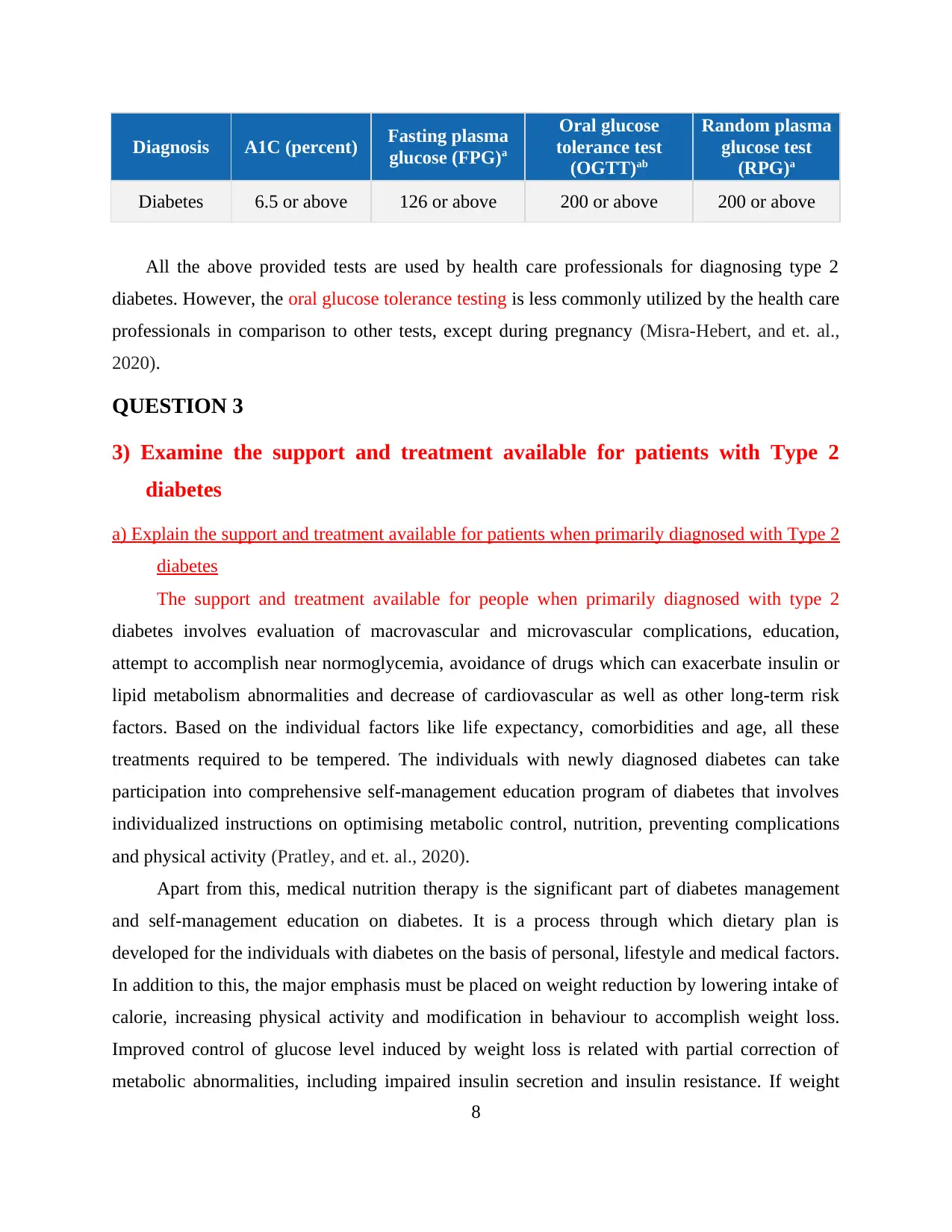
Diagnosis A1C (percent) Fasting plasma
glucose (FPG)a
Oral glucose
tolerance test
(OGTT)ab
Random plasma
glucose test
(RPG)a
Diabetes 6.5 or above 126 or above 200 or above 200 or above
All the above provided tests are used by health care professionals for diagnosing type 2
diabetes. However, the oral glucose tolerance testing is less commonly utilized by the health care
professionals in comparison to other tests, except during pregnancy (Misra-Hebert, and et. al.,
2020).
QUESTION 3
3) Examine the support and treatment available for patients with Type 2
diabetes
a) Explain the support and treatment available for patients when primarily diagnosed with Type 2
diabetes
The support and treatment available for people when primarily diagnosed with type 2
diabetes involves evaluation of macrovascular and microvascular complications, education,
attempt to accomplish near normoglycemia, avoidance of drugs which can exacerbate insulin or
lipid metabolism abnormalities and decrease of cardiovascular as well as other long-term risk
factors. Based on the individual factors like life expectancy, comorbidities and age, all these
treatments required to be tempered. The individuals with newly diagnosed diabetes can take
participation into comprehensive self-management education program of diabetes that involves
individualized instructions on optimising metabolic control, nutrition, preventing complications
and physical activity (Pratley, and et. al., 2020).
Apart from this, medical nutrition therapy is the significant part of diabetes management
and self-management education on diabetes. It is a process through which dietary plan is
developed for the individuals with diabetes on the basis of personal, lifestyle and medical factors.
In addition to this, the major emphasis must be placed on weight reduction by lowering intake of
calorie, increasing physical activity and modification in behaviour to accomplish weight loss.
Improved control of glucose level induced by weight loss is related with partial correction of
metabolic abnormalities, including impaired insulin secretion and insulin resistance. If weight
8
glucose (FPG)a
Oral glucose
tolerance test
(OGTT)ab
Random plasma
glucose test
(RPG)a
Diabetes 6.5 or above 126 or above 200 or above 200 or above
All the above provided tests are used by health care professionals for diagnosing type 2
diabetes. However, the oral glucose tolerance testing is less commonly utilized by the health care
professionals in comparison to other tests, except during pregnancy (Misra-Hebert, and et. al.,
2020).
QUESTION 3
3) Examine the support and treatment available for patients with Type 2
diabetes
a) Explain the support and treatment available for patients when primarily diagnosed with Type 2
diabetes
The support and treatment available for people when primarily diagnosed with type 2
diabetes involves evaluation of macrovascular and microvascular complications, education,
attempt to accomplish near normoglycemia, avoidance of drugs which can exacerbate insulin or
lipid metabolism abnormalities and decrease of cardiovascular as well as other long-term risk
factors. Based on the individual factors like life expectancy, comorbidities and age, all these
treatments required to be tempered. The individuals with newly diagnosed diabetes can take
participation into comprehensive self-management education program of diabetes that involves
individualized instructions on optimising metabolic control, nutrition, preventing complications
and physical activity (Pratley, and et. al., 2020).
Apart from this, medical nutrition therapy is the significant part of diabetes management
and self-management education on diabetes. It is a process through which dietary plan is
developed for the individuals with diabetes on the basis of personal, lifestyle and medical factors.
In addition to this, the major emphasis must be placed on weight reduction by lowering intake of
calorie, increasing physical activity and modification in behaviour to accomplish weight loss.
Improved control of glucose level induced by weight loss is related with partial correction of
metabolic abnormalities, including impaired insulin secretion and insulin resistance. If weight
8
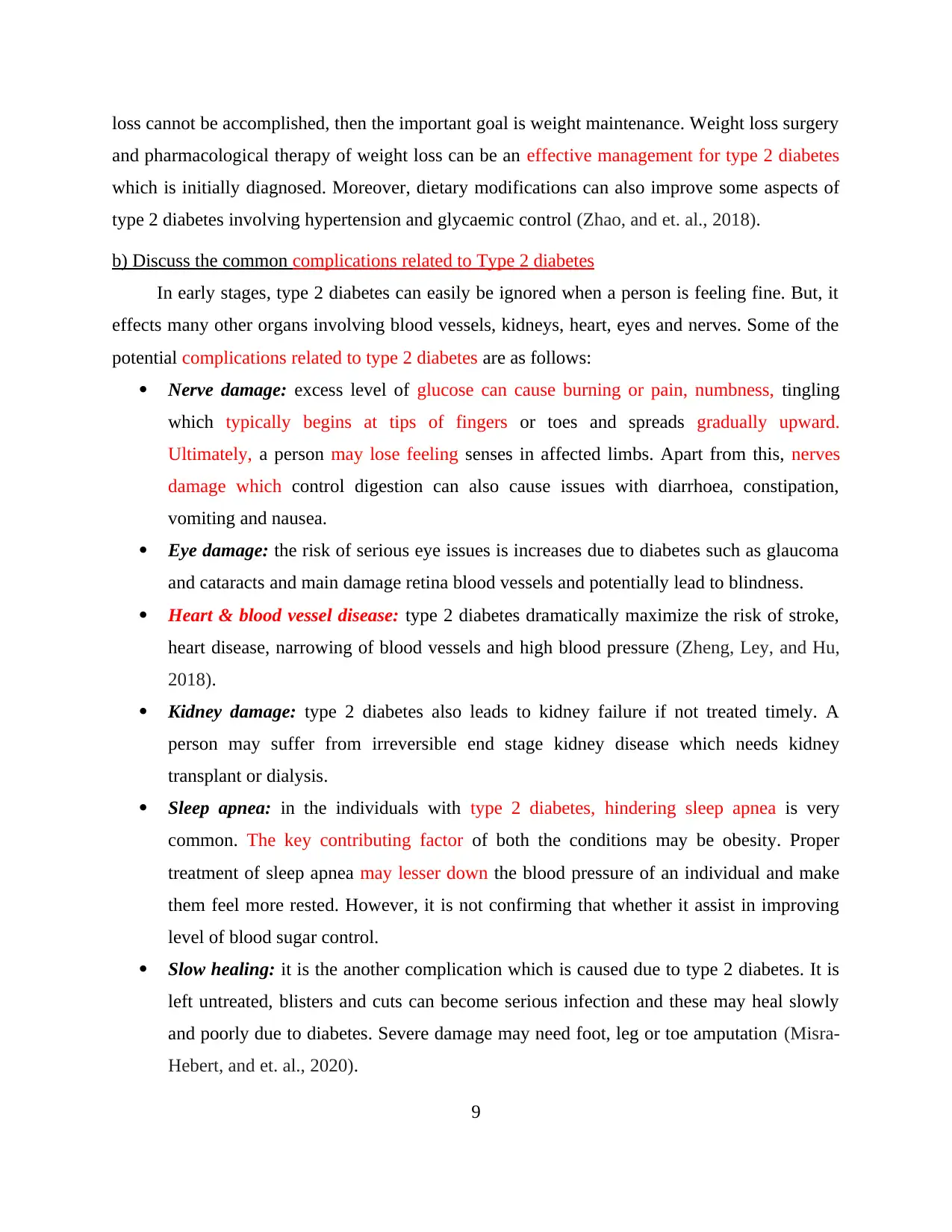
loss cannot be accomplished, then the important goal is weight maintenance. Weight loss surgery
and pharmacological therapy of weight loss can be an effective management for type 2 diabetes
which is initially diagnosed. Moreover, dietary modifications can also improve some aspects of
type 2 diabetes involving hypertension and glycaemic control (Zhao, and et. al., 2018).
b) Discuss the common complications related to Type 2 diabetes
In early stages, type 2 diabetes can easily be ignored when a person is feeling fine. But, it
effects many other organs involving blood vessels, kidneys, heart, eyes and nerves. Some of the
potential complications related to type 2 diabetes are as follows:
Nerve damage: excess level of glucose can cause burning or pain, numbness, tingling
which typically begins at tips of fingers or toes and spreads gradually upward.
Ultimately, a person may lose feeling senses in affected limbs. Apart from this, nerves
damage which control digestion can also cause issues with diarrhoea, constipation,
vomiting and nausea.
Eye damage: the risk of serious eye issues is increases due to diabetes such as glaucoma
and cataracts and main damage retina blood vessels and potentially lead to blindness.
Heart & blood vessel disease: type 2 diabetes dramatically maximize the risk of stroke,
heart disease, narrowing of blood vessels and high blood pressure (Zheng, Ley, and Hu,
2018).
Kidney damage: type 2 diabetes also leads to kidney failure if not treated timely. A
person may suffer from irreversible end stage kidney disease which needs kidney
transplant or dialysis.
Sleep apnea: in the individuals with type 2 diabetes, hindering sleep apnea is very
common. The key contributing factor of both the conditions may be obesity. Proper
treatment of sleep apnea may lesser down the blood pressure of an individual and make
them feel more rested. However, it is not confirming that whether it assist in improving
level of blood sugar control.
Slow healing: it is the another complication which is caused due to type 2 diabetes. It is
left untreated, blisters and cuts can become serious infection and these may heal slowly
and poorly due to diabetes. Severe damage may need foot, leg or toe amputation (Misra-
Hebert, and et. al., 2020).
9
and pharmacological therapy of weight loss can be an effective management for type 2 diabetes
which is initially diagnosed. Moreover, dietary modifications can also improve some aspects of
type 2 diabetes involving hypertension and glycaemic control (Zhao, and et. al., 2018).
b) Discuss the common complications related to Type 2 diabetes
In early stages, type 2 diabetes can easily be ignored when a person is feeling fine. But, it
effects many other organs involving blood vessels, kidneys, heart, eyes and nerves. Some of the
potential complications related to type 2 diabetes are as follows:
Nerve damage: excess level of glucose can cause burning or pain, numbness, tingling
which typically begins at tips of fingers or toes and spreads gradually upward.
Ultimately, a person may lose feeling senses in affected limbs. Apart from this, nerves
damage which control digestion can also cause issues with diarrhoea, constipation,
vomiting and nausea.
Eye damage: the risk of serious eye issues is increases due to diabetes such as glaucoma
and cataracts and main damage retina blood vessels and potentially lead to blindness.
Heart & blood vessel disease: type 2 diabetes dramatically maximize the risk of stroke,
heart disease, narrowing of blood vessels and high blood pressure (Zheng, Ley, and Hu,
2018).
Kidney damage: type 2 diabetes also leads to kidney failure if not treated timely. A
person may suffer from irreversible end stage kidney disease which needs kidney
transplant or dialysis.
Sleep apnea: in the individuals with type 2 diabetes, hindering sleep apnea is very
common. The key contributing factor of both the conditions may be obesity. Proper
treatment of sleep apnea may lesser down the blood pressure of an individual and make
them feel more rested. However, it is not confirming that whether it assist in improving
level of blood sugar control.
Slow healing: it is the another complication which is caused due to type 2 diabetes. It is
left untreated, blisters and cuts can become serious infection and these may heal slowly
and poorly due to diabetes. Severe damage may need foot, leg or toe amputation (Misra-
Hebert, and et. al., 2020).
9
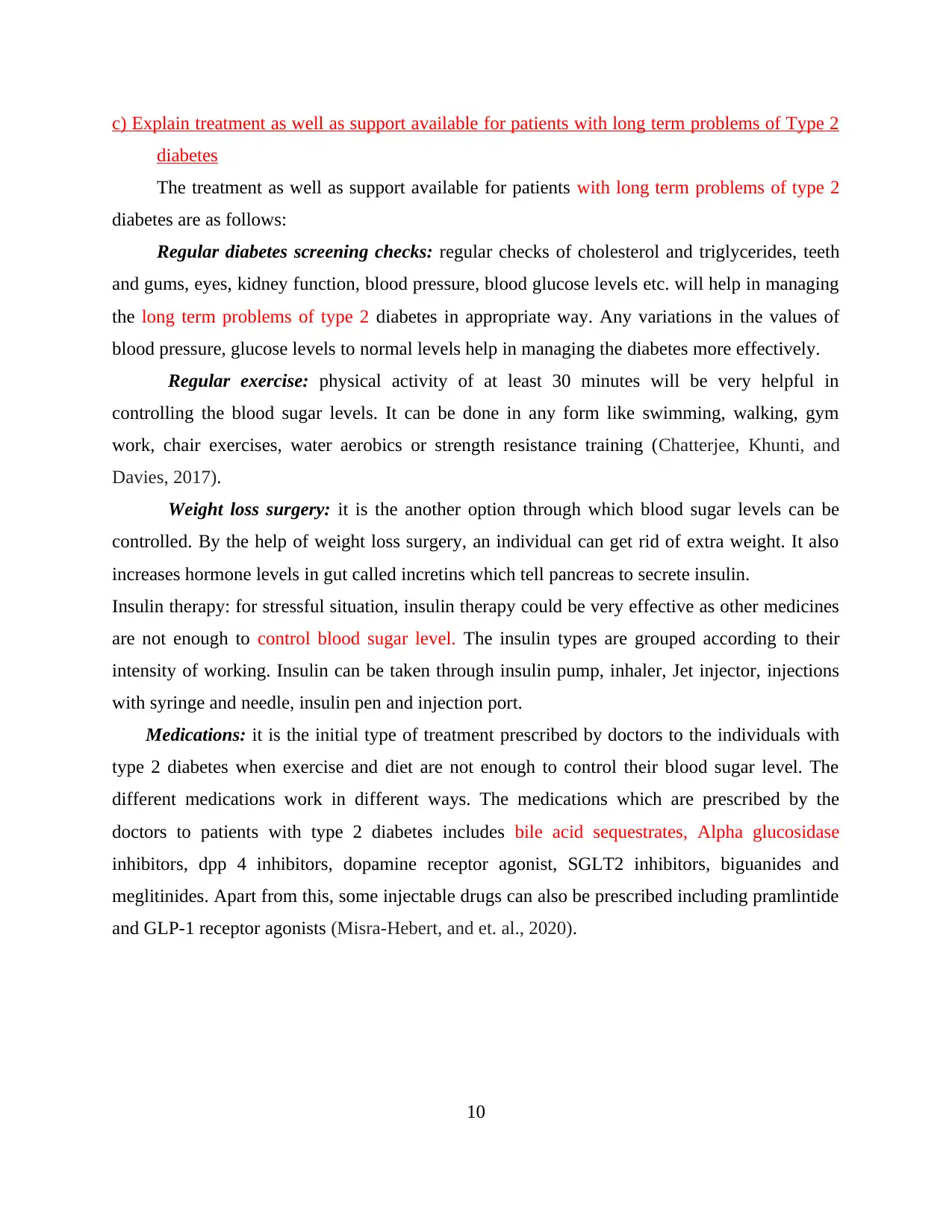
c) Explain treatment as well as support available for patients with long term problems of Type 2
diabetes
The treatment as well as support available for patients with long term problems of type 2
diabetes are as follows:
Regular diabetes screening checks: regular checks of cholesterol and triglycerides, teeth
and gums, eyes, kidney function, blood pressure, blood glucose levels etc. will help in managing
the long term problems of type 2 diabetes in appropriate way. Any variations in the values of
blood pressure, glucose levels to normal levels help in managing the diabetes more effectively.
Regular exercise: physical activity of at least 30 minutes will be very helpful in
controlling the blood sugar levels. It can be done in any form like swimming, walking, gym
work, chair exercises, water aerobics or strength resistance training (Chatterjee, Khunti, and
Davies, 2017).
Weight loss surgery: it is the another option through which blood sugar levels can be
controlled. By the help of weight loss surgery, an individual can get rid of extra weight. It also
increases hormone levels in gut called incretins which tell pancreas to secrete insulin.
Insulin therapy: for stressful situation, insulin therapy could be very effective as other medicines
are not enough to control blood sugar level. The insulin types are grouped according to their
intensity of working. Insulin can be taken through insulin pump, inhaler, Jet injector, injections
with syringe and needle, insulin pen and injection port.
Medications: it is the initial type of treatment prescribed by doctors to the individuals with
type 2 diabetes when exercise and diet are not enough to control their blood sugar level. The
different medications work in different ways. The medications which are prescribed by the
doctors to patients with type 2 diabetes includes bile acid sequestrates, Alpha glucosidase
inhibitors, dpp 4 inhibitors, dopamine receptor agonist, SGLT2 inhibitors, biguanides and
meglitinides. Apart from this, some injectable drugs can also be prescribed including pramlintide
and GLP-1 receptor agonists (Misra-Hebert, and et. al., 2020).
10
diabetes
The treatment as well as support available for patients with long term problems of type 2
diabetes are as follows:
Regular diabetes screening checks: regular checks of cholesterol and triglycerides, teeth
and gums, eyes, kidney function, blood pressure, blood glucose levels etc. will help in managing
the long term problems of type 2 diabetes in appropriate way. Any variations in the values of
blood pressure, glucose levels to normal levels help in managing the diabetes more effectively.
Regular exercise: physical activity of at least 30 minutes will be very helpful in
controlling the blood sugar levels. It can be done in any form like swimming, walking, gym
work, chair exercises, water aerobics or strength resistance training (Chatterjee, Khunti, and
Davies, 2017).
Weight loss surgery: it is the another option through which blood sugar levels can be
controlled. By the help of weight loss surgery, an individual can get rid of extra weight. It also
increases hormone levels in gut called incretins which tell pancreas to secrete insulin.
Insulin therapy: for stressful situation, insulin therapy could be very effective as other medicines
are not enough to control blood sugar level. The insulin types are grouped according to their
intensity of working. Insulin can be taken through insulin pump, inhaler, Jet injector, injections
with syringe and needle, insulin pen and injection port.
Medications: it is the initial type of treatment prescribed by doctors to the individuals with
type 2 diabetes when exercise and diet are not enough to control their blood sugar level. The
different medications work in different ways. The medications which are prescribed by the
doctors to patients with type 2 diabetes includes bile acid sequestrates, Alpha glucosidase
inhibitors, dpp 4 inhibitors, dopamine receptor agonist, SGLT2 inhibitors, biguanides and
meglitinides. Apart from this, some injectable drugs can also be prescribed including pramlintide
and GLP-1 receptor agonists (Misra-Hebert, and et. al., 2020).
10
Secure Best Marks with AI Grader
Need help grading? Try our AI Grader for instant feedback on your assignments.
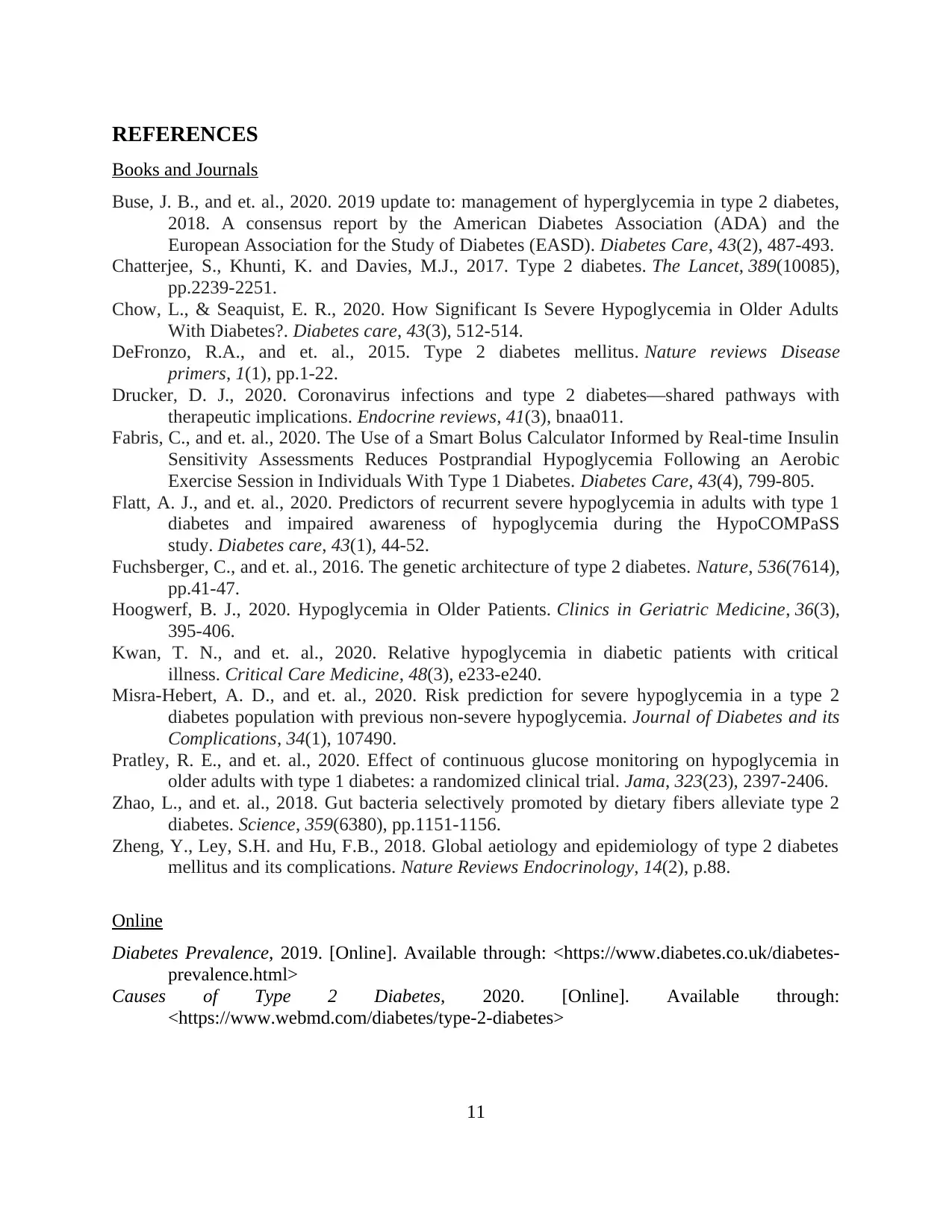
REFERENCES
Books and Journals
Buse, J. B., and et. al., 2020. 2019 update to: management of hyperglycemia in type 2 diabetes,
2018. A consensus report by the American Diabetes Association (ADA) and the
European Association for the Study of Diabetes (EASD). Diabetes Care, 43(2), 487-493.
Chatterjee, S., Khunti, K. and Davies, M.J., 2017. Type 2 diabetes. The Lancet, 389(10085),
pp.2239-2251.
Chow, L., & Seaquist, E. R., 2020. How Significant Is Severe Hypoglycemia in Older Adults
With Diabetes?. Diabetes care, 43(3), 512-514.
DeFronzo, R.A., and et. al., 2015. Type 2 diabetes mellitus. Nature reviews Disease
primers, 1(1), pp.1-22.
Drucker, D. J., 2020. Coronavirus infections and type 2 diabetes—shared pathways with
therapeutic implications. Endocrine reviews, 41(3), bnaa011.
Fabris, C., and et. al., 2020. The Use of a Smart Bolus Calculator Informed by Real-time Insulin
Sensitivity Assessments Reduces Postprandial Hypoglycemia Following an Aerobic
Exercise Session in Individuals With Type 1 Diabetes. Diabetes Care, 43(4), 799-805.
Flatt, A. J., and et. al., 2020. Predictors of recurrent severe hypoglycemia in adults with type 1
diabetes and impaired awareness of hypoglycemia during the HypoCOMPaSS
study. Diabetes care, 43(1), 44-52.
Fuchsberger, C., and et. al., 2016. The genetic architecture of type 2 diabetes. Nature, 536(7614),
pp.41-47.
Hoogwerf, B. J., 2020. Hypoglycemia in Older Patients. Clinics in Geriatric Medicine, 36(3),
395-406.
Kwan, T. N., and et. al., 2020. Relative hypoglycemia in diabetic patients with critical
illness. Critical Care Medicine, 48(3), e233-e240.
Misra-Hebert, A. D., and et. al., 2020. Risk prediction for severe hypoglycemia in a type 2
diabetes population with previous non-severe hypoglycemia. Journal of Diabetes and its
Complications, 34(1), 107490.
Pratley, R. E., and et. al., 2020. Effect of continuous glucose monitoring on hypoglycemia in
older adults with type 1 diabetes: a randomized clinical trial. Jama, 323(23), 2397-2406.
Zhao, L., and et. al., 2018. Gut bacteria selectively promoted by dietary fibers alleviate type 2
diabetes. Science, 359(6380), pp.1151-1156.
Zheng, Y., Ley, S.H. and Hu, F.B., 2018. Global aetiology and epidemiology of type 2 diabetes
mellitus and its complications. Nature Reviews Endocrinology, 14(2), p.88.
Online
Diabetes Prevalence, 2019. [Online]. Available through: <https://www.diabetes.co.uk/diabetes-
prevalence.html>
Causes of Type 2 Diabetes, 2020. [Online]. Available through:
<https://www.webmd.com/diabetes/type-2-diabetes>
11
Books and Journals
Buse, J. B., and et. al., 2020. 2019 update to: management of hyperglycemia in type 2 diabetes,
2018. A consensus report by the American Diabetes Association (ADA) and the
European Association for the Study of Diabetes (EASD). Diabetes Care, 43(2), 487-493.
Chatterjee, S., Khunti, K. and Davies, M.J., 2017. Type 2 diabetes. The Lancet, 389(10085),
pp.2239-2251.
Chow, L., & Seaquist, E. R., 2020. How Significant Is Severe Hypoglycemia in Older Adults
With Diabetes?. Diabetes care, 43(3), 512-514.
DeFronzo, R.A., and et. al., 2015. Type 2 diabetes mellitus. Nature reviews Disease
primers, 1(1), pp.1-22.
Drucker, D. J., 2020. Coronavirus infections and type 2 diabetes—shared pathways with
therapeutic implications. Endocrine reviews, 41(3), bnaa011.
Fabris, C., and et. al., 2020. The Use of a Smart Bolus Calculator Informed by Real-time Insulin
Sensitivity Assessments Reduces Postprandial Hypoglycemia Following an Aerobic
Exercise Session in Individuals With Type 1 Diabetes. Diabetes Care, 43(4), 799-805.
Flatt, A. J., and et. al., 2020. Predictors of recurrent severe hypoglycemia in adults with type 1
diabetes and impaired awareness of hypoglycemia during the HypoCOMPaSS
study. Diabetes care, 43(1), 44-52.
Fuchsberger, C., and et. al., 2016. The genetic architecture of type 2 diabetes. Nature, 536(7614),
pp.41-47.
Hoogwerf, B. J., 2020. Hypoglycemia in Older Patients. Clinics in Geriatric Medicine, 36(3),
395-406.
Kwan, T. N., and et. al., 2020. Relative hypoglycemia in diabetic patients with critical
illness. Critical Care Medicine, 48(3), e233-e240.
Misra-Hebert, A. D., and et. al., 2020. Risk prediction for severe hypoglycemia in a type 2
diabetes population with previous non-severe hypoglycemia. Journal of Diabetes and its
Complications, 34(1), 107490.
Pratley, R. E., and et. al., 2020. Effect of continuous glucose monitoring on hypoglycemia in
older adults with type 1 diabetes: a randomized clinical trial. Jama, 323(23), 2397-2406.
Zhao, L., and et. al., 2018. Gut bacteria selectively promoted by dietary fibers alleviate type 2
diabetes. Science, 359(6380), pp.1151-1156.
Zheng, Y., Ley, S.H. and Hu, F.B., 2018. Global aetiology and epidemiology of type 2 diabetes
mellitus and its complications. Nature Reviews Endocrinology, 14(2), p.88.
Online
Diabetes Prevalence, 2019. [Online]. Available through: <https://www.diabetes.co.uk/diabetes-
prevalence.html>
Causes of Type 2 Diabetes, 2020. [Online]. Available through:
<https://www.webmd.com/diabetes/type-2-diabetes>
11
1 out of 11
Related Documents
Your All-in-One AI-Powered Toolkit for Academic Success.
+13062052269
info@desklib.com
Available 24*7 on WhatsApp / Email
![[object Object]](/_next/static/media/star-bottom.7253800d.svg)
Unlock your academic potential
© 2024 | Zucol Services PVT LTD | All rights reserved.





